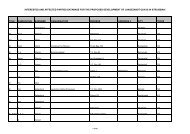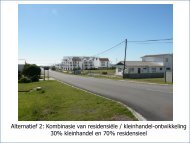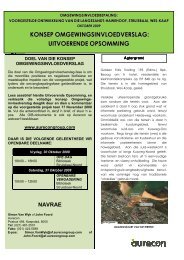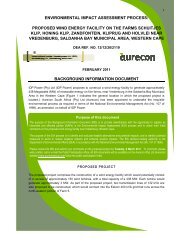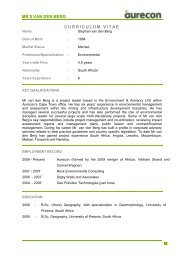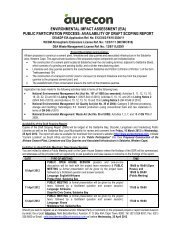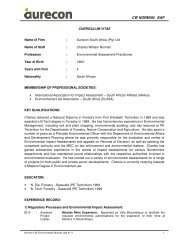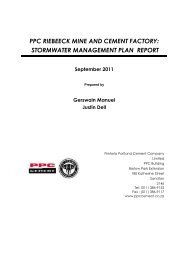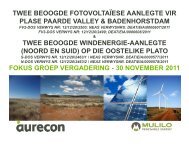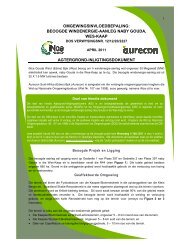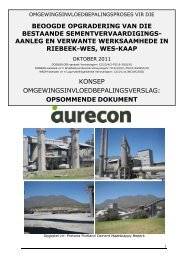Final EIAR - Aurecon AME Environmental | Environmental Projects
Final EIAR - Aurecon AME Environmental | Environmental Projects
Final EIAR - Aurecon AME Environmental | Environmental Projects
Create successful ePaper yourself
Turn your PDF publications into a flip-book with our unique Google optimized e-Paper software.
Proposed Wind and Solar (Photovoltaic) Energy Facilities on Kangnas Farm near Springbok in the Northern Cape: <strong>Final</strong> EIR 120<br />
b) Description of the environment<br />
Geological environment<br />
The study area is situated within the arid Bushmanland region between Springbok and<br />
Pofadder. The region is of special geological and palaeontological interest in that the study<br />
area is mantled by unconsolidated Quaternary to Recent superficial sediments. These include a<br />
range of quartz-rich alluvial sands and gravels, skeletal soils, colluvial deposits such as<br />
bouldery or blocky scree, sandy, arkosic (feldspar-rich) and gravelly sheet wash and slope<br />
deposits derived from weathering of the surrounding granite-gneiss terrain and wind-blown<br />
(aeolian) sands. These last may probably be equated with the Quaternary Gordonia Formation<br />
of the Kalahari Group.<br />
The geological map of the region approximately 50 km east of Springbok, Northern Cape,<br />
indicates the following outcrop areas of the main rock units represented within the site (Figure<br />
4.37).<br />
• Mid Proterozoic (Mokolian / Kheisian) metamorphic rocks of the Bushmanland Group<br />
and Gladkop Metamorphic Suite<br />
• Early to Mid Proterozoic (Mokolian / Namaquan) metamorphic and intrusive igneous<br />
rocks of the Little Namaqualand Suite, Korridor Suite<br />
• Tertiary / Quaternary calcrete (pedogenic limestone)<br />
• Quaternary aeolian (wind-blown) sands, probably equivalent to the Gordonia Formation<br />
(Kalahari Group)<br />
• Quaternary sand, scree, rubble, sandy soils of alluvial and colluvial origin<br />
• Kimberlite volcanic pipe<br />
• Olivine melilitite volcanic pipe<br />
• Permo-carboniferous Mbizane Formation (Dwyka Group, Pmb)<br />
Pans and water courses are often associated with thick developments of calcrete (pedogenic<br />
limestone). Calcrete hardpans that date back to Late Tertiary (Neogene) to Quaternary or<br />
Recent age also occur subsurface and extensive surface exposures are mapped at the southeastern<br />
and south-western edges of the study area.<br />
Several kimberlite and olivine melilitite volcanic pipes of Cretaceous age are mapped just to the<br />
east of the site. Some of these pipes are still associated with fossiliferous crater lake deposits<br />
whose preservation reflects the low levels of landscape denudation since Late Cretaceous times<br />
in the Bushmanland region. Of particular interest is the buried double feeder pipe olivinemelilitite<br />
system with a footprint of some one to two hectares that has been deduced on<br />
geophysical as well as geological grounds at Goebeesvlei in the north-eastern portion of the<br />
site. It is quite possible that other potentially-fossiliferous crater lake deposits are hidden<br />
beneath the Late Caenozoic superficial sediments elsewhere within the site (e.g. calcretecapped<br />
pans).<br />
The site is almost entirely underlain by Mid Proterozoic (Mokolian) basement rocks of the<br />
Namaqua-Natal Metamorphic Province. The basement rocks build the numerous isolated<br />
inselbergs and ridges scattered across the Bushmanland landscape. Small Dwyka Group inliers<br />
(Mbizane Formation, Pmb) are mapped just to the southeast of the site with none recorded<br />
within the site itself.<br />
© <strong>Aurecon</strong> (2012) No unauthorised reproduction, copy<br />
or adaptation, in whole or in part, may be made.<br />
P:\<strong>Projects</strong>\108495 Kangnas WEF & PV EIA's\3 Project Delivery\4 Reports\FEIR\FEIR 210213 <strong>Final</strong>.doc


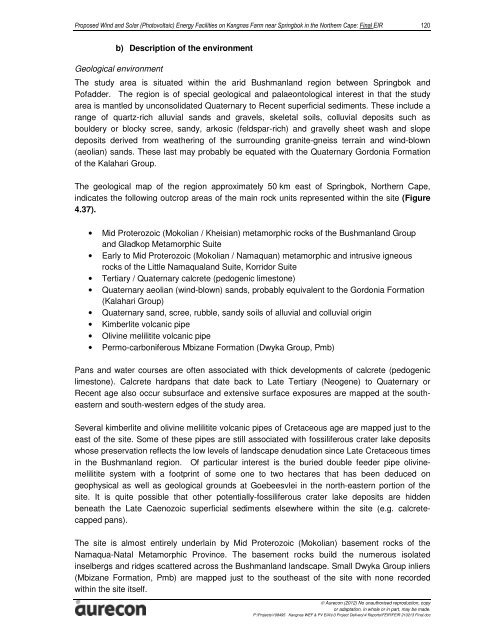
![CRR IV FEIR ~ 26042010 [FINAL].pdf - Environmental Projects](https://img.yumpu.com/21973020/1/184x260/crr-iv-feir-26042010-finalpdf-environmental-projects.jpg?quality=85)
